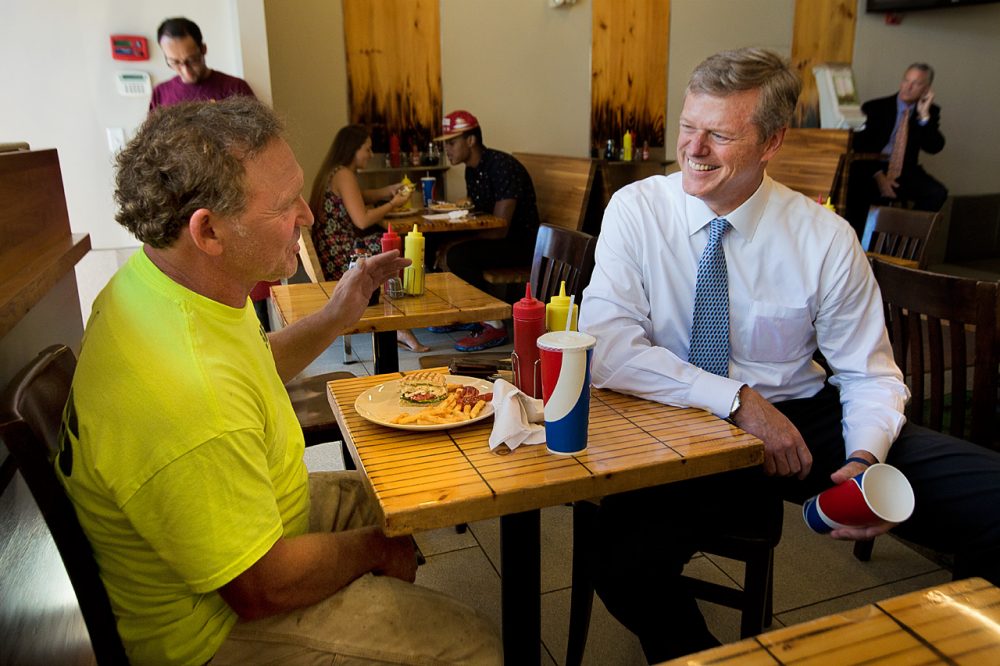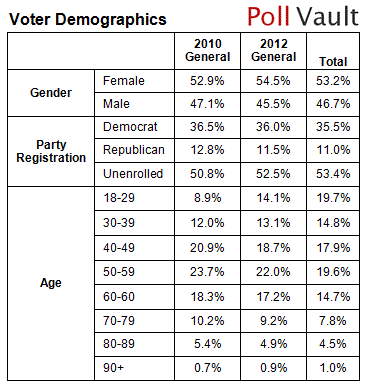Advertisement
Midterm Voters A More Favorable Electorate For Baker

It's a fact of life across the country that turnout in midterm elections like this one is typically considerably lower than in presidential years, and Massachusetts is no different. The last three presidential elections have averaged 3.1 million votes in Massachusetts, compared to 2.3 million each in the last three midterms.
[asset]2014/1024_total-turnout/[/asset]
The primary this year produced a record low turnout compared to past gubernatorial primaries, despite the presence of multiple candidates in both the Democratic and Republican contests. While we can't know for sure if this is indicative of coming lower turnout in the general, we do know that 2014 won't look like 2012.
So, with an average of 26 percent fewer voters at the polls, what changes? When turnout drops off, it's usually older, whiter and wealthier voters that still show up.
Nationally, the trends are clear to see. Exit polls from the 2012 presidential election reported a younger, more diverse electorate than 2010. In 2012, 41 percent of voters earned less than $50,000 a year, compared to 36 percent for voters in 2010. Seventy-two percent of voters in 2012 were white; in 2010, 77 percent were. Voters under 30 made up 19 percent of the electorate in the presidential election but only 12 percent in 2010. Massachusetts demographics differ somewhat but move in the same direction, towards an older, whiter, more affluent midterm electorate.

As analysts have pointed out, these demographic trends are likely to make an already bad situation worse for Democrats nationally. Democrats talk about trying to engage presidential voters in midterms, but they have yet to crack the code. If they could, it would change the face of the political map, since Republicans have been able to rely on a more conservative midterm electorate. But for now, the drop-off voters are younger and more diverse — just the groups with whom Democrats tend to dominate.
Looking at Massachusetts specifically, we can get a sense of demographic shifts by comparing the voters who cast ballots in the 2010 midterm and the 2012 presidential elections, according to the state voter file. The electorate in 2010 was slightly more male and Republican than in 2012, but only by a percentage point or two. The demographic that shifts the most is age: Older voters play a much bigger role in midterms than they do in presidential years, while voters under 30 have only made up 9 percent of voters in recent midterms, despite being 20 percent of registered voters.
Advertisement
As the chart above shows, there is a point around age 70 where turnout begins to decline again. This could be because older voters can't get to the polls, due to illness, infirmity or lack of mobility. But another possibility is that older voters' names remain on the voter rolls despite their having moved out of state or passed away. This would have the effect of inflating the number of older voters thereby making the percentage figures look artificially low.
A similar phenomenon may also depress the turnout percentage for younger voters: If students who registered in Massachusetts but then moved out of state are still on the rolls, that would overstate the number of young registered votes. Putting that aside, according to the voter file, a 100-year-old voter is still more likely to show up for a midterm than an 18-year-old.
Where voters come from also changes in midterms. A drop-off in urban voting is one of the defining characteristics of midterm elections, both here and nationally. As you can see from the map below, turnout in 2010 fell off, compared to 2012, by a larger percentage in Boston and other big cities than elsewhere in the state. This drop-off in midterm voting is also tied to the racial and socioeconomic makeup of towns. The scatter-plot below the map shows 2010 turnout in larger cities with lower median household incomes and more non-white residents fell more than elsewhere.
[asset]2014/1024_midterm-dropoff/[/asset]
We observed the same trends in when looking at voting on ballots questions in Massachusetts. Voters from larger, poorer and more non-white cities are more likely to vote for the elected offices but "blank" the ballot questions. In a midterm year, this phenomenon is magnified by the fact that there are fewer voters from those cities coming out in the first place. So if midterm voters are older, whiter, wealthier and more suburban, the subset of those voters deciding the ballot questions in a midterm year are even more so.
Even though cities carry less weight in midterm elections than in presidential years, they are still heavy hitters in terms of the raw votes they produce. Urban areas are the key to this year's election, as Paul McMorrow summarized in CommonWealth Magazine:
The Brown, Patrick, and Warren victories all speak to a changed electoral landscape. Urban communities are now handing Republicans far more lopsided defeats than they were when Baker’s old bosses, Weld and Cellucci, were winning their races for governor. So it’s not enough anymore for Republicans seeking statewide office in Massachusetts to crank away in the suburbs. They also have to pay serious attention to their margins in the cities, where demographic shifts are making Massachusetts urban centers increasingly hostile places for Republicans.
The Baker campaign has made a major push to narrow the margins in these large urban areas, and it may be working. The WBUR Tracking Poll has shown Martha Coakley's margins in urban areas narrowing from 21 points in late August to 9 points in the latest round of polling. If these margins hold, Baker will have succeeded at keeping things closer in the cities, which greatly improves his chances of victory. Plotting all of the respondents to the WBUR Tracking Poll on a map shows a similar dynamic. Baker is making inroads with urban voters. Meanwhile, Coakley has yet to close the sale, leaving an above-average number of undecided voters in the cities.
So how big of a deal is it if Charlie Baker is successful in the cities? Big. The cartograms below show where Democrats and Republicans have gotten their votes in recent midterm and special elections. Just as in the primaries, Boston and cities are important to both parties, but far more so to Democrats than Republicans.
[asset]2014/1024_where-votes/[/asset]
Boston has accounted for 9 percent of Democratic votes in recent cycles, compared to 4 percent for Republicans. That 4 percent makes Boston the biggest vote source of votes for Republicans, as well. Other Democratic strongholds such as Worcester and Springfield are also very important to Republicans, even though they typically lose badly there.
In other words, there are more votes for Republicans in places where they lose than in places where they win. Focusing on narrowing the Democrats' margins in these big towns, rather than running up the score in Republican towns, will net more raw votes. For instance, if Baker had shaved 2 points off Deval Patrick's margin in Boston in 2010, he would have yielded more votes than if he'd won every single Democratic vote in Bourne or Bridgewater, both towns he won comfortably in 2010.
The bigger demographic differences between midterms and presidential years play out within individuals cities as well. Republican candidates may have a slightly friendlier urban electorate in a midterm because the city voters who do show up will likely be whiter and wealthier.
Outside the cities, the Republican vote is more evenly distributed. The GOP map shows more medium sized squares in the central and southern parts of the state. The last few general elections have featured Republican sweeps from Framingham to Springfield, with the blue island of Worcester floating in a sea of red. The heavily regionalized map of Massachusetts has locked Democrats out of most of the suburbs the same way it has locked Republicans out of most of the cities.
Just as nationally, the voters showing up at the polls in Massachusetts next week are likely to be older, whiter, wealthier, and more suburban than the voters who cast ballots in presidential years. All this translates to a more favorable electorate for Charlie Baker and other Republicans running. So while Republicans face an uphill battle in Massachusetts, in midterm years, the slope is a little less steep.
Steve Koczela is the lead writer for Poll Vault and president of The MassINC Polling Group. Rich Parr is research director of The MassINC Polling Group.